Anil Jain
A Quality-Guided Mixture of Score-Fusion Experts Framework for Human Recognition
Jul 31, 2025Abstract:Whole-body biometric recognition is a challenging multimodal task that integrates various biometric modalities, including face, gait, and body. This integration is essential for overcoming the limitations of unimodal systems. Traditionally, whole-body recognition involves deploying different models to process multiple modalities, achieving the final outcome by score-fusion (e.g., weighted averaging of similarity matrices from each model). However, these conventional methods may overlook the variations in score distributions of individual modalities, making it challenging to improve final performance. In this work, we present \textbf{Q}uality-guided \textbf{M}ixture of score-fusion \textbf{E}xperts (QME), a novel framework designed for improving whole-body biometric recognition performance through a learnable score-fusion strategy using a Mixture of Experts (MoE). We introduce a novel pseudo-quality loss for quality estimation with a modality-specific Quality Estimator (QE), and a score triplet loss to improve the metric performance. Extensive experiments on multiple whole-body biometric datasets demonstrate the effectiveness of our proposed approach, achieving state-of-the-art results across various metrics compared to baseline methods. Our method is effective for multimodal and multi-model, addressing key challenges such as model misalignment in the similarity score domain and variability in data quality.
50 Years of Automated Face Recognition
May 30, 2025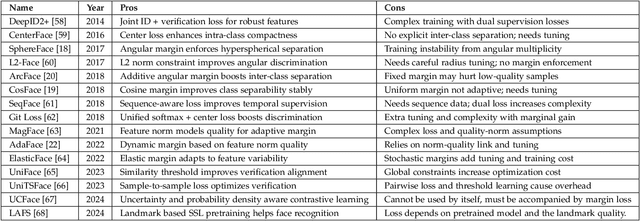
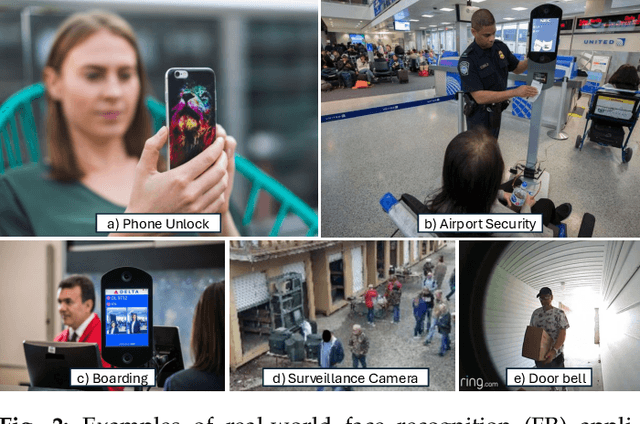

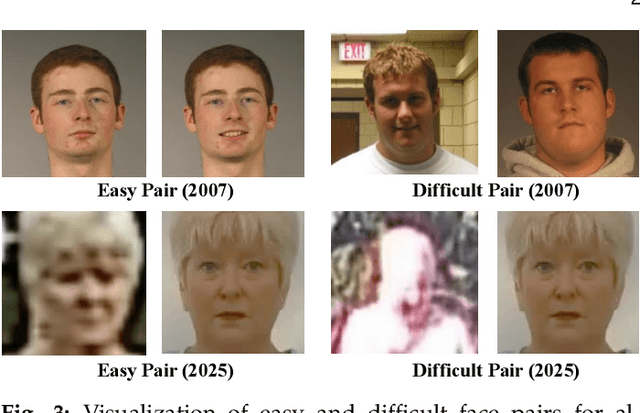
Abstract:Over the past 50 years, automated face recognition has evolved from rudimentary, handcrafted systems into sophisticated deep learning models that rival and often surpass human performance. This paper chronicles the history and technological progression of FR, from early geometric and statistical methods to modern deep neural architectures leveraging massive real and AI-generated datasets. We examine key innovations that have shaped the field, including developments in dataset, loss function, neural network design and feature fusion. We also analyze how the scale and diversity of training data influence model generalization, drawing connections between dataset growth and benchmark improvements. Recent advances have achieved remarkable milestones: state-of-the-art face verification systems now report False Negative Identification Rates of 0.13% against a 12.4 million gallery in NIST FRVT evaluations for 1:N visa-to-border matching. While recent advances have enabled remarkable accuracy in high- and low-quality face scenarios, numerous challenges persist. While remarkable progress has been achieved, several open research problems remain. We outline critical challenges and promising directions for future face recognition research, including scalability, multi-modal fusion, synthetic identity generation, and explainable systems.
Person Recognition at Altitude and Range: Fusion of Face, Body Shape and Gait
May 07, 2025Abstract:We address the problem of whole-body person recognition in unconstrained environments. This problem arises in surveillance scenarios such as those in the IARPA Biometric Recognition and Identification at Altitude and Range (BRIAR) program, where biometric data is captured at long standoff distances, elevated viewing angles, and under adverse atmospheric conditions (e.g., turbulence and high wind velocity). To this end, we propose FarSight, a unified end-to-end system for person recognition that integrates complementary biometric cues across face, gait, and body shape modalities. FarSight incorporates novel algorithms across four core modules: multi-subject detection and tracking, recognition-aware video restoration, modality-specific biometric feature encoding, and quality-guided multi-modal fusion. These components are designed to work cohesively under degraded image conditions, large pose and scale variations, and cross-domain gaps. Extensive experiments on the BRIAR dataset, one of the most comprehensive benchmarks for long-range, multi-modal biometric recognition, demonstrate the effectiveness of FarSight. Compared to our preliminary system, this system achieves a 34.1% absolute gain in 1:1 verification accuracy (TAR@0.1% FAR), a 17.8% increase in closed-set identification (Rank-20), and a 34.3% reduction in open-set identification errors (FNIR@1% FPIR). Furthermore, FarSight was evaluated in the 2025 NIST RTE Face in Video Evaluation (FIVE), which conducts standardized face recognition testing on the BRIAR dataset. These results establish FarSight as a state-of-the-art solution for operational biometric recognition in challenging real-world conditions.
Adversarial Watermarking for Face Recognition
Sep 24, 2024Abstract:Watermarking is an essential technique for embedding an identifier (i.e., watermark message) within digital images to assert ownership and monitor unauthorized alterations. In face recognition systems, watermarking plays a pivotal role in ensuring data integrity and security. However, an adversary could potentially interfere with the watermarking process, significantly impairing recognition performance. We explore the interaction between watermarking and adversarial attacks on face recognition models. Our findings reveal that while watermarking or input-level perturbation alone may have a negligible effect on recognition accuracy, the combined effect of watermarking and perturbation can result in an adversarial watermarking attack, significantly degrading recognition performance. Specifically, we introduce a novel threat model, the adversarial watermarking attack, which remains stealthy in the absence of watermarking, allowing images to be correctly recognized initially. However, once watermarking is applied, the attack is activated, causing recognition failures. Our study reveals a previously unrecognized vulnerability: adversarial perturbations can exploit the watermark message to evade face recognition systems. Evaluated on the CASIA-WebFace dataset, our proposed adversarial watermarking attack reduces face matching accuracy by 67.2% with an $\ell_\infty$ norm-measured perturbation strength of ${2}/{255}$ and by 95.9% with a strength of ${4}/{255}$.
Data Pruning via Separability, Integrity, and Model Uncertainty-Aware Importance Sampling
Sep 20, 2024



Abstract:This paper improves upon existing data pruning methods for image classification by introducing a novel pruning metric and pruning procedure based on importance sampling. The proposed pruning metric explicitly accounts for data separability, data integrity, and model uncertainty, while the sampling procedure is adaptive to the pruning ratio and considers both intra-class and inter-class separation to further enhance the effectiveness of pruning. Furthermore, the sampling method can readily be applied to other pruning metrics to improve their performance. Overall, the proposed approach scales well to high pruning ratio and generalizes better across different classification models, as demonstrated by experiments on four benchmark datasets, including the fine-grained classification scenario.
On Missing Scores in Evolving Multibiometric Systems
Aug 21, 2024



Abstract:The use of multiple modalities (e.g., face and fingerprint) or multiple algorithms (e.g., three face comparators) has shown to improve the recognition accuracy of an operational biometric system. Over time a biometric system may evolve to add new modalities, retire old modalities, or be merged with other biometric systems. This can lead to scenarios where there are missing scores corresponding to the input probe set. Previous work on this topic has focused on either the verification or identification tasks, but not both. Further, the proportion of missing data considered has been less than 50%. In this work, we study the impact of missing score data for both the verification and identification tasks. We show that the application of various score imputation methods along with simple sum fusion can improve recognition accuracy, even when the proportion of missing scores increases to 90%. Experiments show that fusion after score imputation outperforms fusion with no imputation. Specifically, iterative imputation with K nearest neighbors consistently surpasses other imputation methods in both the verification and identification tasks, regardless of the amount of scores missing, and provides imputed values that are consistent with the ground truth complete dataset.
Open-Set Biometrics: Beyond Good Closed-Set Models
Jul 23, 2024Abstract:Biometric recognition has primarily addressed closed-set identification, assuming all probe subjects are in the gallery. However, most practical applications involve open-set biometrics, where probe subjects may or may not be present in the gallery. This poses distinct challenges in effectively distinguishing individuals in the gallery while minimizing false detections. While it is commonly believed that powerful biometric models can excel in both closed- and open-set scenarios, existing loss functions are inconsistent with open-set evaluation. They treat genuine (mated) and imposter (non-mated) similarity scores symmetrically and neglect the relative magnitudes of imposter scores. To address these issues, we simulate open-set evaluation using minibatches during training and introduce novel loss functions: (1) the identification-detection loss optimized for open-set performance under selective thresholds and (2) relative threshold minimization to reduce the maximum negative score for each probe. Across diverse biometric tasks, including face recognition, gait recognition, and person re-identification, our experiments demonstrate the effectiveness of the proposed loss functions, significantly enhancing open-set performance while positively impacting closed-set performance. Our code and models are available at https://github.com/prevso1088/open-set-biometrics.
Hide and Seek: How Does Watermarking Impact Face Recognition?
Apr 29, 2024



Abstract:The recent progress in generative models has revolutionized the synthesis of highly realistic images, including face images. This technological development has undoubtedly helped face recognition, such as training data augmentation for higher recognition accuracy and data privacy. However, it has also introduced novel challenges concerning the responsible use and proper attribution of computer generated images. We investigate the impact of digital watermarking, a technique for embedding ownership signatures into images, on the effectiveness of face recognition models. We propose a comprehensive pipeline that integrates face image generation, watermarking, and face recognition to systematically examine this question. The proposed watermarking scheme, based on an encoder-decoder architecture, successfully embeds and recovers signatures from both real and synthetic face images while preserving their visual fidelity. Through extensive experiments, we unveil that while watermarking enables robust image attribution, it results in a slight decline in face recognition accuracy, particularly evident for face images with challenging poses and expressions. Additionally, we find that directly training face recognition models on watermarked images offers only a limited alleviation of this performance decline. Our findings underscore the intricate trade off between watermarking and face recognition accuracy. This work represents a pivotal step towards the responsible utilization of generative models in face recognition and serves to initiate discussions regarding the broader implications of watermarking in biometrics.
KeyPoint Relative Position Encoding for Face Recognition
Mar 21, 2024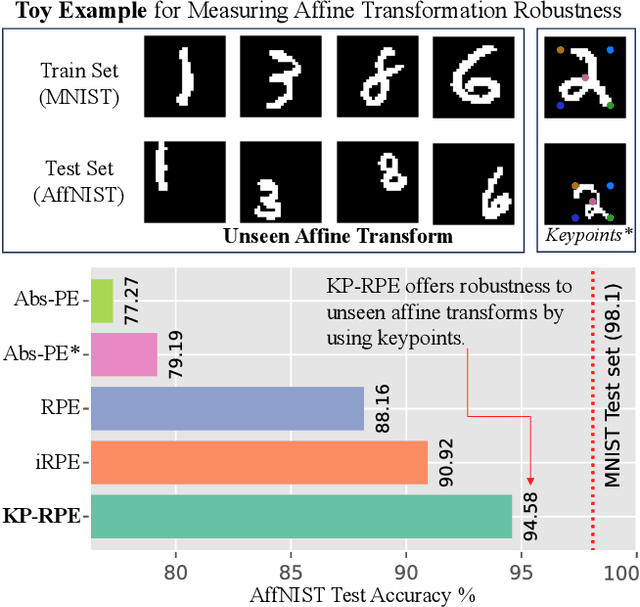

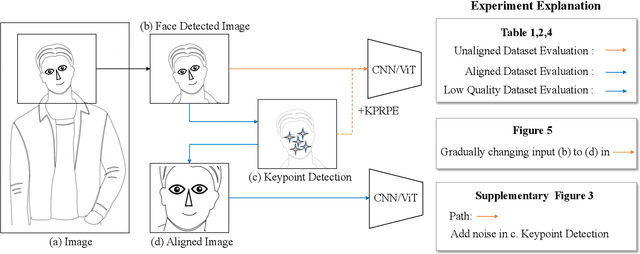
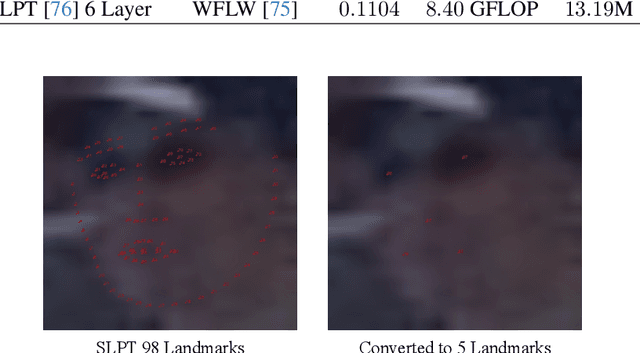
Abstract:In this paper, we address the challenge of making ViT models more robust to unseen affine transformations. Such robustness becomes useful in various recognition tasks such as face recognition when image alignment failures occur. We propose a novel method called KP-RPE, which leverages key points (e.g.~facial landmarks) to make ViT more resilient to scale, translation, and pose variations. We begin with the observation that Relative Position Encoding (RPE) is a good way to bring affine transform generalization to ViTs. RPE, however, can only inject the model with prior knowledge that nearby pixels are more important than far pixels. Keypoint RPE (KP-RPE) is an extension of this principle, where the significance of pixels is not solely dictated by their proximity but also by their relative positions to specific keypoints within the image. By anchoring the significance of pixels around keypoints, the model can more effectively retain spatial relationships, even when those relationships are disrupted by affine transformations. We show the merit of KP-RPE in face and gait recognition. The experimental results demonstrate the effectiveness in improving face recognition performance from low-quality images, particularly where alignment is prone to failure. Code and pre-trained models are available.
Learning Clothing and Pose Invariant 3D Shape Representation for Long-Term Person Re-Identification
Aug 29, 2023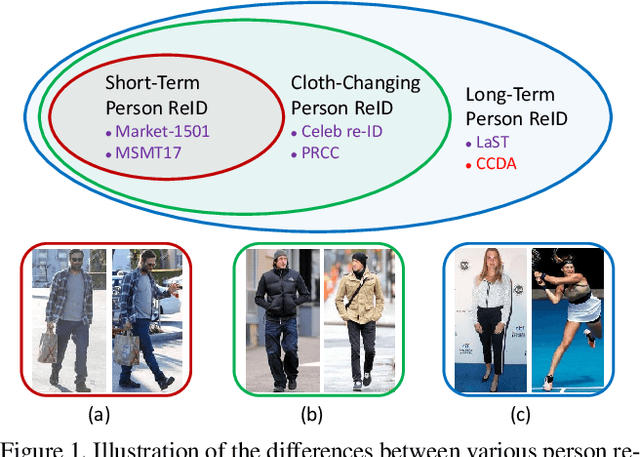
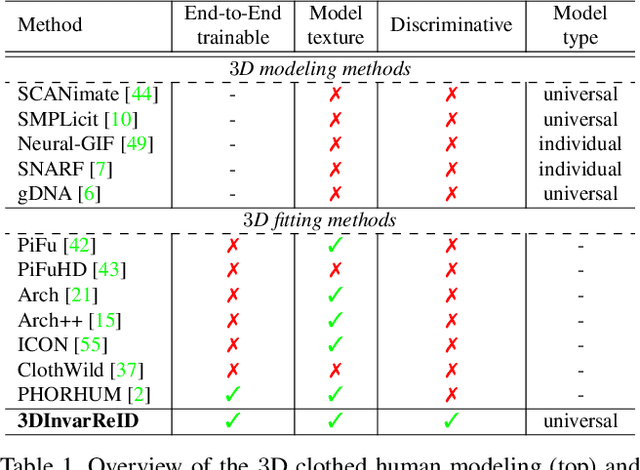
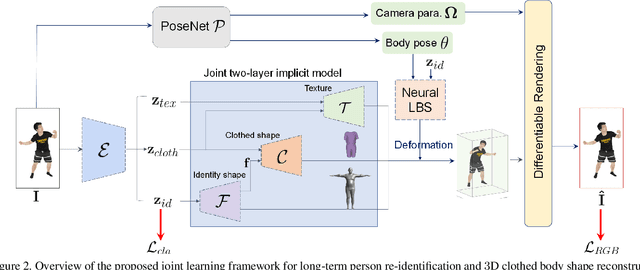
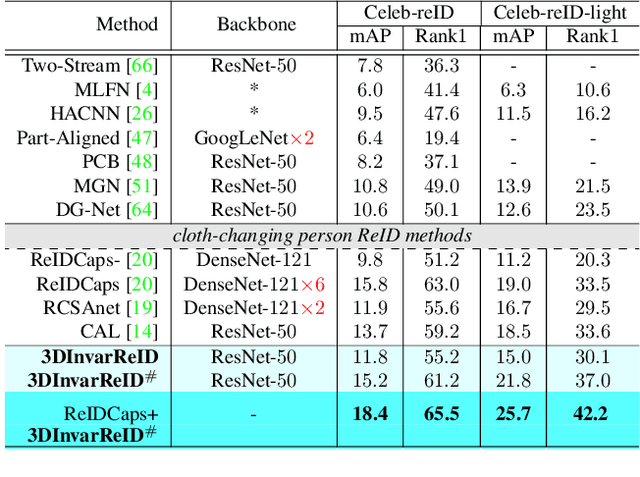
Abstract:Long-Term Person Re-Identification (LT-ReID) has become increasingly crucial in computer vision and biometrics. In this work, we aim to extend LT-ReID beyond pedestrian recognition to include a wider range of real-world human activities while still accounting for cloth-changing scenarios over large time gaps. This setting poses additional challenges due to the geometric misalignment and appearance ambiguity caused by the diversity of human pose and clothing. To address these challenges, we propose a new approach 3DInvarReID for (i) disentangling identity from non-identity components (pose, clothing shape, and texture) of 3D clothed humans, and (ii) reconstructing accurate 3D clothed body shapes and learning discriminative features of naked body shapes for person ReID in a joint manner. To better evaluate our study of LT-ReID, we collect a real-world dataset called CCDA, which contains a wide variety of human activities and clothing changes. Experimentally, we show the superior performance of our approach for person ReID.
 Add to Chrome
Add to Chrome Add to Firefox
Add to Firefox Add to Edge
Add to Edge